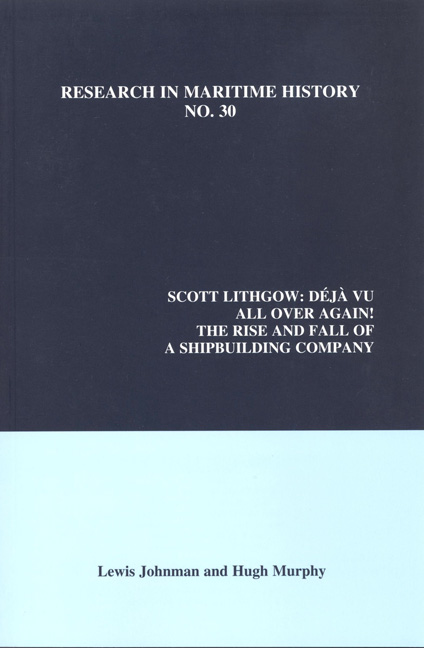Book contents
- Frontmatter
- Contents
- Acknowledgement
- Introduction
- Chapter 1 Scotts of Greenock, 1711-1945
- Chapter 2 Russell and Company to Lithgows Limited, 1874-1945
- Chapter 3 Scotts Shipbuilding and Engineering, 1945-1965
- Chapter 4 Lithgows Limited, 1945-1965
- Chapter 5 The Long March to Merger, 1965-1970
- Chapter 6 The Road to Nationalisation, 1970-1977
- Chapter 7 Nationalisation to Privatisation, 1977-1984
- Chapter 8 Déjà vu All over Again: Trafalgar House, 1984-1988
- Chapter 9 Conclusion
- Appendix
- Bibliography
Chapter 1 - Scotts of Greenock, 1711-1945
- Frontmatter
- Contents
- Acknowledgement
- Introduction
- Chapter 1 Scotts of Greenock, 1711-1945
- Chapter 2 Russell and Company to Lithgows Limited, 1874-1945
- Chapter 3 Scotts Shipbuilding and Engineering, 1945-1965
- Chapter 4 Lithgows Limited, 1945-1965
- Chapter 5 The Long March to Merger, 1965-1970
- Chapter 6 The Road to Nationalisation, 1970-1977
- Chapter 7 Nationalisation to Privatisation, 1977-1984
- Chapter 8 Déjà vu All over Again: Trafalgar House, 1984-1988
- Chapter 9 Conclusion
- Appendix
- Bibliography
Summary
In 1711 John Scott, a native of Roxburgh, established a small shipyard at the mouth of the West Burn in Greenock where he built bluff-bowed herring busses, crewed by no more than four men. His sons, James and William Scott I, continued the business under their names and in 1765 built the first large, square-rigged ship on the Clyde for owners outside Scotland. The founder's grandson, the second John Scott, extended the yard by building a dry dock and basin and acquired the Greenock Foundry in 1790.
Daniel Weir's History of Greenock informs us that by the early nineteenth century the shipyard of Scott and Sons was “the most complete in Britain, excepting those belonging to the Crown.” Weir's statement in all likelihood was subjective and reflected local pride. The firm had again changed its name in 1802 to become John Scott and Sons. By this stage, however, John Scott II's brother, William Scott II, had already decamped to Barnstaple in Devon to build vessels. John Scott III, in partnership with Robert Sinclair (his future son-in-law), in 1825 purchased a former brass and iron foundry in Greenock from William Brownlie to manufacture his own marine engines. On a co-partnership basis with the shipbuilding arm, this firm became known as Scott Sinclair and Company but reverted to the title of the Greenock Foundry Company in 1859. The initial outlay of £5000 for the Brownlie works proved a shrewd investment, and by 1839 Scotts’ engine building arm employed around 220 men in the manufacture of steam engines.
In 1794 Scotts completed the largest ship built in Scotland up to that time, the 650-ton Caledonia, for the carriage of timber to naval dockyards. The firm for a period concentrated on building wooden square- and fore-andaft- rigged vessels, but diversified to take account of technical developments. As a result, by the time of the publication of Weir's history in 1839, Scotts concentrated mainly on steamers and steam engines. Prior to this, Scotts claimed to have been the first Scottish firm to build a warship for the Admiralty, the sloop-of-war Prince of Wales in 1803. But it was not until 1849 that it launched its first naval vessel of note, an iron-screw frigate appropriately named HMS Greenock. This began a long association with the Admiralty, a relationship that remained at the heart of the firm's future output.
- Type
- Chapter
- Information
- Scott LithgowDéjà Vu all over again! The Rise and Fall of a Shipbuilding Company, pp. 1 - 28Publisher: Liverpool University PressPrint publication year: 2005



